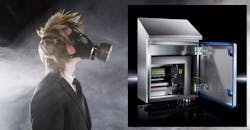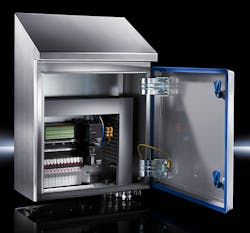Design Enclosures that Protect Against Harsh Environments
In many industries, the environment can shorten the life of switchgear and controls. Harsh, corrosive chemicals, frequent washdowns, saltwater, and airborne contaminants are just some of the hazards that enclosures must fight against to deliver protection year-after-year.
Oil and gas and food and beverage are particularly challenging, but for completely different reasons.
Oil and Gas Environments
There are a variety of environments in the oil and gas industry that make enclosure decisions important. For offshore platforms in the ocean, enclosures need to withstand corrosive saltwater (even applications five miles inland from the ocean could suffer from saltwater). At oil refineries, enclosures could be exposed to oil and chemicals directly, along with gas or vapors that could become explosive.
When considering enclosures for these types of environments, high-grade stainless steel is an important choice. The highest grades are T304 and 316L. The latter stands up to corrosion better and is a harder stainless steel, but it is also more expensive.
Another consideration is whether the cabinets can withstand pressure and purge applications, as the box must be protected from explosives. Purging is a way to constantly remove any contaminants from the inside of the box. Pressure is a way to constantly blow inert gas into the box so no explosive gasses get inside. It is important to work with an integrator for the pressure and purge modifications that will work with the selected enclosure.
The best way to withstand washdown environments is FDA-approved silicon gaskets. These gaskets are blue to provide greater visibility of materials on them. (Courtesy: Rittal)
Food and Beverage Environments
Food and beverage plants don’t have the same harsh environments as oil and gas, but potentially explosive environments can also occur in some food and beverage plants.
These plants have hygienic zones, which encompass anywhere food touches machinery. Those areas need continual cleaning, mostly with high-pressure washdowns with hot water and sanitizing agents. Most plants will specify the highest grades of stainless steel to withstand that environment.
Washdowns can attack different parts of the enclosure, including the door gasket, hinges, and the rood ridge above the door. Therefore, enclosures need to be designed without dead space where water accumulates and bacteria can grow. All water needs to drain away from the enclosure.
The best way to withstand that environment is FDA-approved silicon gasket. A colored gasket can provide greater visibility of gasket materials. Many hygienic-designed enclosures use this material to secure water from entering the enclosure. Unlike foam gaskets, silicon can endure the repetition of washdowns and harsh chemicals. While robotically foamed-in-place gaskets with no seams are an option, these may not have the long service life of silicon. Seams may contract or expand with temperature fluctuations, which can allow bacteria and chemicals into the enclosure and require more frequent foam gasket replacement.
Another area is the wipedown environment. The design of the enclosure should be the same as the hygienic zone, but there is less emphasis on high pressure liquids getting inside. Stainless steel enclosures are still the preferable material for this area.
Steve Sullivan is training supervisor at Rittal.
About the Author
Steve Sullivan
Training & Development Supervisor
Steve Sullivan is the Training Supervisor at Rittal North America LLC where he oversees instructor-led, computer- and web-based learning and development. In over 20 years with Rittal, Steve also worked in production control, managed tradeshows and exhibits, and conducted sales training for both industrial and IT products in the Americas and abroad. Steve co-founded Rittal University Online and is the North American point-of-contact for Rittal’s Global Trainer Network. Steve has a B.S. in Psychology from Wright State University, and an MBA from the University of Phoenix.


